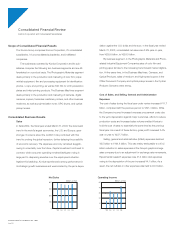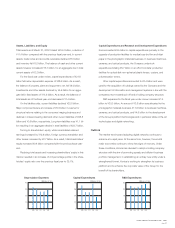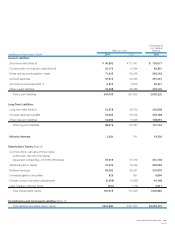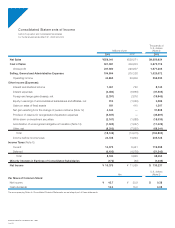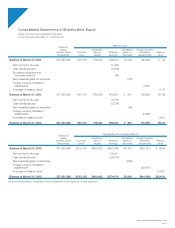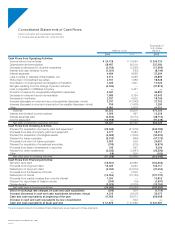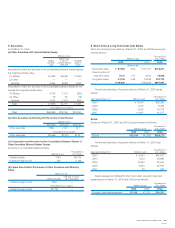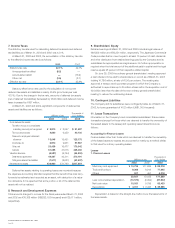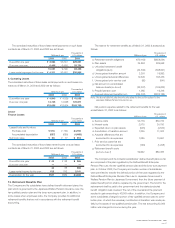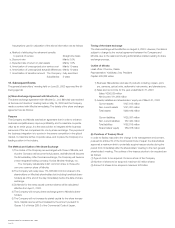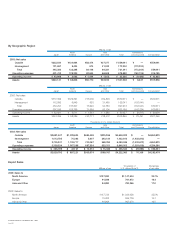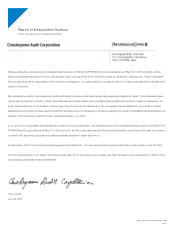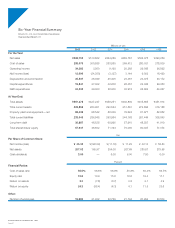Konica Minolta 2003 Annual Report Download - page 35
Download and view the complete annual report
Please find page 35 of the 2003 Konica Minolta annual report below. You can navigate through the pages in the report by either clicking on the pages listed below, or by using the keyword search tool below to find specific information within the annual report.
KONICA M INOLTA HOLDINGS, INC. 2 0 0 3
Pag e 33
No tes to Co nso lidated Financ ial Statem ents
Konica Corporation and Consolidated Subsidiaries
For the fiscal years ended March 31, 2003 and 2002
1. Basis of Presenting Financial Statements
The accompanying consolidated financial statements have been prepared
based on the accounts maintained by Konica Corporation (the “Company”)
and its consolidated subsidiaries in accordance with the provisions set forth
in the Japanese Commercial Code (the “Code”) and the Securities and
Exchange Law, and in conformity with accounting principles and practices
generally accepted in Japan, which are different in certain respects from the
application and disclosure requirements of International Accounting
Standards.
Certain items presented in the consolidated financial statements submit-
ted to the Director of Kanto Finance Bureau in Japan have been reclassified
in these accounts for the convenience of readers outside Japan.
Certain amounts previously reported have been reclassified to conform
to the current year classifications.
As permitted under the Securities and Exchange Law of Japan, amounts
of less than one million yen have been omitted. As a result, the totals shown
in the accompanying consolidated financial statements (both in yen and in
dollars) do not necessarily agree with the sums of the individual amounts.
The consolidated financial statements are not intended to present the
consolidated financial position, results of operations and cash flows in accor-
dance with accounting principles and practices generally accepted in coun-
tries and jurisdictions other than Japan.
2. Summary of Significant Accounting Policies
(a) Principles of Consolidation
The consolidated financial statements include the accounts of the Company
and, with certain exceptions which are not material, those of its 75 sub-
sidiaries in which it has control. All significant intercompany transactions and
accounts and unrealized profits among the companies are eliminated in
consolidation.
Investments in 15 unconsolidated subsidiaries and 3 significant affiliates
are accounted for by the equity method. Investments in 3 insignificant
unconsolidated affiliates are stated at cost.
The excess of cost over the underlying investments in subsidiaries is rec-
ognized as goodwill and is amortized on a straight-line basis over a five-year
period.
(b) Translation of Foreign Currencies
Translation of Foreign Currency Transactions
All monetary assets and liabilities denominated in foreign currencies, whether
long-term or short-term, are translated into Japanese yen at the exchange
rates prevailing at the balance sheet date and revenues and costs are trans-
lated using average exchange rate for the period.
Translation of Foreign Currency Financial Statements
The translations of foreign currency financial statements of overseas consoli-
dated subsidiaries and affiliates into Japanese yen are made by applying the
exchange rates prevailing at the balance sheet dates for balance sheet items,
except that the common stock, additional paid-in capital and retained earn-
ings accounts are translated at the historical rates and the statements of
income and retained earnings are translated at average exchange rates.
(c) Cash and Cash Equivalents
Cash and cash equivalents in the consolidated statements of cash flows are
composed of cash on hand, bank deposits able to be withdrawn on demand
and short-term investments with an original maturity of three months or less
and which represent a minor risk of fluctuation in value.
(d) Allowance for Doubtful Accounts
The allowance for doubtful accounts is provided at the amount of possible
losses from uncollectable receivables based on the management’s estimate.
(e) Inventories
Inventories are valued principally on an average-cost basis.
(f) Property, Plant and Equipment Depreciation
Depreciation of property, plant and equipment for the Company and domes-
tic consolidated subsidiaries is computed using the declining balance
method except for depreciation of buildings acquired after April 1, 1998,
based on the estimated useful lives of assets.
Depreciation of buildings acquired after April 1, 1998 is computed using
the straight-line method. Depreciation of foreign subsidiaries is computed
using the straight-line method.
Ordinary maintenance and repairs are charged to income as incurred.
Major replacements and improvements are capitalized. When properties are
retired or otherwise disposed of, the property and related accumulated
depreciation accounts are relieved of the applicable amounts and any differ-
ences are charged or credited to income.
(g) Income Taxes
Income taxes of the Company and its domestic subsidiaries consist of cor-
porate income taxes, local inhabitants’ taxes, and enterprise taxes. Deferred
income taxes are provided for in respect of temporary differences between
the tax basis of assets and liabilities and those as reported in the consoli-
dated financial statements.
(h) Research and Development Expenses
Expenses for research and development activities are charged to income as
incurred.
(i) Financial Instruments
Derivatives
All derivatives are stated at fair value, with changes in fair value included in
net profit or loss for the period in which they arise, except for derivatives that
are designated as “hedging instruments” (see Hedge Accounting below).



